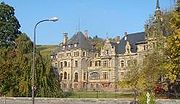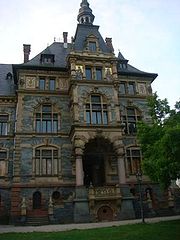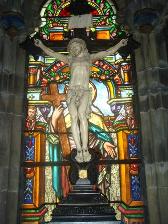
Schloss Lieser
Encyclopedia
Schloss Lieser in the Mosel
valley nearby Bernkastel-Kues
is one of the most striking buildings within the village of Lieser.

The castle was created on the site of a 1710-built church property.
Today's castle was designed by the architect Heinrich Theodor Schmidt in 1884-1887 as the residence for the family of the winery owner Eduard Puricelli
. Eduard Puricelli
founded and led several gas industries, including in Trier
and also in the Rheinböller hut. Puricelli applied several times for Catholic and conservative parties to Members mandates and belonged to the constituent Reichstag
of the North German Confederation
. After the German-French war 1870/71 Puricelli continued for economic reasons, together with eleven other companies in Trier
for the Annexation of Alsace-Lorraine
.
Eduard Puricellis daughter Maria, sole heiress of parental possessions, married in 1880 the high Prussian officer Dr. Clemens Freiherr von Schorlemer-Alst/ Clemens Freiherr von Schorlemer-Lieser
(1856–1922).
Through its activities in the Prussian administrative services Clemens von Schorlemer made the acquaintance Kaiser Wilhelm II, who appreciated him.
In 1895/1904-1906 the castle was largely extended when Maria and Dr Clemens Freiherr von Schorlemer moved into the castle . The castle consists out of two components, the older part in forms of Neo-Renaissance and the younger part in the forms of Art Nouveau.
, but in outline - according to the architect - Neo-Gothic. The jewellery forms bays, gables and towers are oriented to the German forms of Late Renaissance. The entrance is protected by a tower were two free-standing granite columns rise. The Risalit on the left side of the main facade is Risalit by large, spread over two floors, is emphasized. The remarkable Madonna statue at the corner near the chapel comes from Peter Fuchs
, who also worked at the Cologne Cathedral
. Equal worth mentioning are the images of the main facade. At various points representations from the fields of industry and agriculture. For the stone construction Mosel slates and red - on the ground floor - brighter Udelfanger sandstone where used. The roof has been made from the slate quarries of Cauber Erbstollens.

The ground floor, in which mainly economic areas and the bottling plants were located, has been created very high for reasons of flood protection.
In the stairwell between eight large pilasters painted landscapes and architectural motifs from the Mosel region created by Karl Julius Grätz are located. The stairwell window with lead glazing has four painted medallions of Binsfeld and Janssen in Trier
. The staircase itself is a self-construction of Trier sandstone with wrought-iron, partly gilded railings.
from Düsseldorf
.
created the saint statues. The mosaic floor with his figural representations was designed by the architect and produced in Mettlach
.

With regard to the various facilities the following can be mentioned: the carpentry work, furniture and other equipment details were drawings of the architects of Epple and Ege in Stuttgart
. From the company M. Armbruster in Frankfurt
the construction locks and art metalwork were created.
. The main pavilion is a mid-wing, which served as a wintergarden. In front of the central axis of the three-pavilion construction a three-Söller has been placed. The entrance to a building along is followed by a concrete tower. Inside the extended building is in one of the two staircases the remarkable Art Nouveau
railing.
Mosel
Mosel may mean the following:* Moselle , a European river, named Mosel in German* Mosel , a German appellation, formerly known as Mosel-Saar-Ruwer** Mosel wine, wine produced in the region...
valley nearby Bernkastel-Kues
Bernkastel-Kues
Bernkastel-Kues is a well-known winegrowing centre on the Middle Moselle in the Bernkastel-Wittlich district in Rhineland-Palatinate, Germany...
is one of the most striking buildings within the village of Lieser.
Historical background

The castle was created on the site of a 1710-built church property.
Today's castle was designed by the architect Heinrich Theodor Schmidt in 1884-1887 as the residence for the family of the winery owner Eduard Puricelli
Eduard Puricelli
- Career :Puricelli founded and led several gas campanies in Trier and in the Rheinböller hut. Puricelli ran several times as a representative of Catholic and conservative parties to Members mandates and belonged to the constituent Reichstag of the North German Confederation...
. Eduard Puricelli
Eduard Puricelli
- Career :Puricelli founded and led several gas campanies in Trier and in the Rheinböller hut. Puricelli ran several times as a representative of Catholic and conservative parties to Members mandates and belonged to the constituent Reichstag of the North German Confederation...
founded and led several gas industries, including in Trier
Trier
Trier, historically called in English Treves is a city in Germany on the banks of the Moselle. It is the oldest city in Germany, founded in or before 16 BC....
and also in the Rheinböller hut. Puricelli applied several times for Catholic and conservative parties to Members mandates and belonged to the constituent Reichstag
Reichstag (German Empire)
The Reichstag was the parliament of the North German Confederation , and of the German Reich ....
of the North German Confederation
North German Confederation
The North German Confederation 1866–71, was a federation of 22 independent states of northern Germany. It was formed by a constitution accepted by the member states in 1867 and controlled military and foreign policy. It included the new Reichstag, a parliament elected by universal manhood...
. After the German-French war 1870/71 Puricelli continued for economic reasons, together with eleven other companies in Trier
Trier
Trier, historically called in English Treves is a city in Germany on the banks of the Moselle. It is the oldest city in Germany, founded in or before 16 BC....
for the Annexation of Alsace-Lorraine
Alsace-Lorraine
The Imperial Territory of Alsace-Lorraine was a territory created by the German Empire in 1871 after it annexed most of Alsace and the Moselle region of Lorraine following its victory in the Franco-Prussian War. The Alsatian part lay in the Rhine Valley on the west bank of the Rhine River and east...
.
Eduard Puricellis daughter Maria, sole heiress of parental possessions, married in 1880 the high Prussian officer Dr. Clemens Freiherr von Schorlemer-Alst/ Clemens Freiherr von Schorlemer-Lieser
Clemens Freiherr von Schorlemer-Lieser
Clemens August von Schorlemer-Lieser was a German politician.-Historical background:Freiherr von Schorlemer was born in Horstmar. After he graduated from the Gymnasium Dionysianum in Rheine in 1874, he studied law in Würzburg and Göttingen. In 1878 he achieved his doctorate and went into military...
(1856–1922).
Through its activities in the Prussian administrative services Clemens von Schorlemer made the acquaintance Kaiser Wilhelm II, who appreciated him.
In 1895/1904-1906 the castle was largely extended when Maria and Dr Clemens Freiherr von Schorlemer moved into the castle . The castle consists out of two components, the older part in forms of Neo-Renaissance and the younger part in the forms of Art Nouveau.
External side
The external side is mainly influenced by the Neo-RenaissanceNeo-Renaissance
Renaissance Revival is an all-encompassing designation that covers many 19th century architectural revival styles which were neither Grecian nor Gothic but which instead drew inspiration from a wide range of classicizing Italian modes...
, but in outline - according to the architect - Neo-Gothic. The jewellery forms bays, gables and towers are oriented to the German forms of Late Renaissance. The entrance is protected by a tower were two free-standing granite columns rise. The Risalit on the left side of the main facade is Risalit by large, spread over two floors, is emphasized. The remarkable Madonna statue at the corner near the chapel comes from Peter Fuchs
Peter Fuchs
Peter Fuchs was a German sculptor.-Biography:From 1844 to 1849 Peter Fuchs was an apprentice mason in the Cologne Dombauhütte and for the next two years he worked as a mason for St...
, who also worked at the Cologne Cathedral
Cologne Cathedral
Cologne Cathedral is a Roman Catholic church in Cologne, Germany. It is the seat of the Archbishop of Cologne and the administration of the Archdiocese of Cologne. It is renowned monument of German Catholicism and Gothic architecture and is a World Heritage Site...
. Equal worth mentioning are the images of the main facade. At various points representations from the fields of industry and agriculture. For the stone construction Mosel slates and red - on the ground floor - brighter Udelfanger sandstone where used. The roof has been made from the slate quarries of Cauber Erbstollens.

Ground plan, ground floor and staircase
The ground plan is located between the Mosel and the mountains, so that all rooms within the building - as in the English country houses - are represented against a long corridor. The basic design of the building plan with the octagonal hall is based on Italian villas buildings of the 16th (Palladio) and 17th age centure.The ground floor, in which mainly economic areas and the bottling plants were located, has been created very high for reasons of flood protection.
In the stairwell between eight large pilasters painted landscapes and architectural motifs from the Mosel region created by Karl Julius Grätz are located. The stairwell window with lead glazing has four painted medallions of Binsfeld and Janssen in Trier
Trier
Trier, historically called in English Treves is a city in Germany on the banks of the Moselle. It is the oldest city in Germany, founded in or before 16 BC....
. The staircase itself is a self-construction of Trier sandstone with wrought-iron, partly gilded railings.
First floor
The first floor is a Beletage with representation rooms. In the octagonal hall, where the stairs end, the sculptor's work, the pillars and the wall panelling have been created in light Burgreppacher sandstone. The ceiling has been plastered and contains ceveral paintings. The first floor contains further more spaces: the rather sober work room, reception room, with pitch pine and oak wood-panelled dining room large with a rich and carved wooden ceiling and several doorframes, the small dining room for everyday use, a poolroom, several gardenrooms, guest rooms and a kitchen.Second floor
The second floor is the private sector of the house. Is had been equipped with livingrooms, sleepingrooms, tourist rooms and rooms for servants. It also contains a wandtable and a marble fireplace. The copper plate of the fireplace has been decorated with a presentation of Hubert SalentinHubert Salentin
'Johann Hubert Salentin was a German painter.Salentin was blacksmith for 14 years. It was until 1850 that he came to the Düsseldorf Academy, where Wilhelm von Schadow, Carl Ferdinand son Adolph Tidemand where his main teachers...
from Düsseldorf
Düsseldorf
Düsseldorf is the capital city of the German state of North Rhine-Westphalia and centre of the Rhine-Ruhr metropolitan region.Düsseldorf is an important international business and financial centre and renowned for its fashion and trade fairs. Located centrally within the European Megalopolis, the...
.
Chapel
From the hall of Beletage you get into the chapel, which is a building on its own. The wallpaintings are also made by Karl Julius Grätz. The glass paintings have been made by Binsfeld and Janssen. Peter FuchsPeter Fuchs
Peter Fuchs was a German sculptor.-Biography:From 1844 to 1849 Peter Fuchs was an apprentice mason in the Cologne Dombauhütte and for the next two years he worked as a mason for St...
created the saint statues. The mosaic floor with his figural representations was designed by the architect and produced in Mettlach
Mettlach
Mettlach is a municipality in the district Merzig-Wadern, in Saarland, Germany. It is situated on the river Saar, approx. 7 km northwest of Merzig, and 30 km south of Trier.Villeroy & Boch's headquarters are in Mettlach....
.

The statue of the "housewife" and the other facilities
A special feature of the paintings is the image originally situated on the terrace sculpture of the wife of the owner. With her old German costume, keys and wallet in hand, it symbolizes allegorical excessive.With regard to the various facilities the following can be mentioned: the carpentry work, furniture and other equipment details were drawings of the architects of Epple and Ege in Stuttgart
Stuttgart
Stuttgart is the capital of the state of Baden-Württemberg in southern Germany. The sixth-largest city in Germany, Stuttgart has a population of 600,038 while the metropolitan area has a population of 5.3 million ....
. From the company M. Armbruster in Frankfurt
Frankfurt
Frankfurt am Main , commonly known simply as Frankfurt, is the largest city in the German state of Hesse and the fifth-largest city in Germany, with a 2010 population of 688,249. The urban area had an estimated population of 2,300,000 in 2010...
the construction locks and art metalwork were created.
The extension of 1895/1904-1906
It is unclear whether the extension of the castle was created in 1904-1906, or already built in 1895—the information is to differ. The historicism here takes forms of Art NouveauArt Nouveau
Art Nouveau is an international philosophy and style of art, architecture and applied art—especially the decorative arts—that were most popular during 1890–1910. The name "Art Nouveau" is French for "new art"...
. The main pavilion is a mid-wing, which served as a wintergarden. In front of the central axis of the three-pavilion construction a three-Söller has been placed. The entrance to a building along is followed by a concrete tower. Inside the extended building is in one of the two staircases the remarkable Art Nouveau
Art Nouveau
Art Nouveau is an international philosophy and style of art, architecture and applied art—especially the decorative arts—that were most popular during 1890–1910. The name "Art Nouveau" is French for "new art"...
railing.

